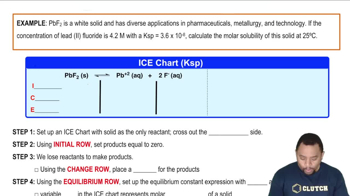Here are the essential concepts you must grasp in order to answer the question correctly.
Molar Solubility
Molar solubility refers to the maximum amount of solute that can dissolve in a given volume of solvent at a specific temperature, expressed in moles per liter. It is a crucial concept in understanding how different substances behave in solution and is influenced by factors such as temperature and the nature of the solute and solvent.
Recommended video:
Solubility Graphs
Solubility graphs visually represent the solubility of various substances in a solvent, typically water, as a function of temperature. Each curve on the graph indicates how the solubility of a specific solute changes with temperature, allowing for easy comparison between different solutes at a given temperature.
Recommended video:
Comparative Analysis
Comparative analysis involves evaluating two or more substances to determine which has a higher or lower property—in this case, molar solubility. By examining the solubility graph, one can estimate the solubility of CH3CO2Na and glucose at 20 °C, facilitating a clear understanding of their relative solubility in water.
Recommended video:

 Verified step by step guidance
Verified step by step guidance


